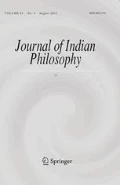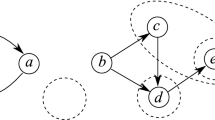Abstract
The strainer (cālanī) tests the strength of a definition of a particular kind. Suppose the definition D is stated in terms of an absence, and x is a definiendum of D. The strainer collects each x-token or x-individual that dissatisfies D in a specific case. Then, all the x-individuals put together would be equivalent to the type x. Hence—one would be forced to conclude that—in a sense, x dissatisfies D. This is a case of under-application of D, since, despite being a definiendum of D, x dissatisfies D. Therefore, D would be too narrow. Similarly, the strainer may detect over-application too. By using the strainer, Raghunātha Śiromaṇi demonstrated that Gaṅgeśa’s conclusive definition of pervasion (vyāpti) had a defect, and redefined pervasion. The strainer test is based on intuitive principles. It may disqualify a definition that has an absence in its definiens. Therefore, strainer-proofing becomes an important consideration that must be borne in mind every time we formulate such a definition.
Similar content being viewed by others
Notes
It was: sādhyâbhāva-vad-avṛttitvam, the first in the set of five famous definitions (vyāpti-pañcaka) Gaṅgeśa refuted. This roughly means: Y pervades X if and only if X never coexists with the absence of Y in any locus. For a detailed discussion, see Ingalls (1988, pp. 90–126).
I shall use the words, ‘definiendum’ and ‘non-definiendum’ in the following sense. A definiendum of the definition D is a case D is supposed to apply to, and a non-definiendum of D is a case D is supposed not to apply to. Consider the following definition:
O: x is oviparous if and only if x produces young by means of eggs.
A sparrow and a man is a definiendum and a non-definiendum of O respectively.
Let us assume that this is true in our Nyāya model.
Mukherjea (1976, p. 8).
Ibid, p. 15.
The word ‘having’ is used in the following sense: ‘an entity has/possesses A’.
Mukherjea (1976, p. 18).
This property makes a set by collecting each and every fire-individual, and then assigns it a membership of that set.
It is because kitchen-fire etc. cannot be there in a hill.
Let us assume that the unordered set of x1 through xn is {x1,…, xn}.
Jagadīśa writes:
na ca parvate mahānasīyo vahnir nâstītyâdi-pratīti-siddhasya hetu-man-niṣṭhâbhāvasya pratiyogitâvacchedakam eva vahnitvam iti avyāpti-tādavasthyaṃ, sādhyatâvacchedaka-tad-itarôbhayâvacchedya-bhinnāyā eva pratiyogitāyā anavacchedakatvasya vivakṣitatvāt. Mukherjea (1976, p. 22)
For a translation of this passage, see Mukherjea (1976, p. 22). Jagadīśa replaces A and P by ‘hetu’ and ‘sādhya’ respectively. I do not want to do that since the original definitions did not do that.
Once again I have deliberately ignored ‘vyāpyavṛtti’ since it is not really relevant to this paper. For a full discussion, see Wada (1994).
In the language of Nyāya, this could be written as: yan-niṣṭhâdheyatā-nirūpitâdhāratā-nirūpitâdheyatā-vad yad bhavati tena samaṃ tasya sāmānādhikaraṇyaṃ vyāptiḥ.
Goekoop (1967, p.111) defines: ‘There is pervasion of A by B if, and only if, A has a common locus with B in such a way that B is none of the things that qua class are completely absent from some locus of A.’
On replacing X and Y by smoke and fire respectively, the definition becomes, ‘Fire pervades smoke if and only if fire-ness does not limit the counterpositive-ness of an absence that coexists with smoke in any locus.’
tat-samānâdhikaraṇâbhāva-pratiyogi tad-virodhi.
Compare this to the case of G1.
yad-rūpa-viśiṣṭa-samānâdhikaraṇâtyantâbhāva-pratiyogitâvacchedako yo dharmo tad-dharmâvacchinnaṃ sarvaṃ tad-rūpa-viśiṣṭasya virodhi.
References
Chakraborty, K. (1978). Definitions of Vyāpti (Pervasion) in Navya-Nyāya: a critical survey. Journal of Indian Philosophy,5, 209–236.
Goekoop, C. (1967). The logic of invariable concomitance in the Tattvacintāmaṇi. Dordrecht: D. Reidel Publishing Company.
Guha, D. C. (1968). Navya-Nyāya system of logic. Varanasi: Bharatiya Vidya Prakashan.
Ingalls, D. H. H. (1988). Materials for the study of Navya-Nyāya logic. New Delhi: Motilal Banarssidas.
Jhalakīkar, M. B. (1928). Nyāyakośa or dictionary of technical terms of Indian Philosophy. Pune: Bhandarkar Oriental Research Institute.
Matilal, B. K. (1998). The character of logic in India. Albany: State University of New York Press.
Mukherjea, A. K. (1976). The definition of pervasion (Vyāpti) in Navya-Nyāya. Journal of Indian Philosophy,4, 1–50.
Wada, T. (1994). A source of Gangeṣa’s conclusive definition of Vyāpti. Journal of Indian and Buddhist Studies, 42(2), 1074–1070.
Wada, T. (2007). The analytical method of Navya-Nyāya. Groningen: Egbert Forsten.
Acknowledgement
I acknowledge my indebtedness to Shruti K. Bhat and Nikhil Ravishankar for their valuable comments on earlier drafts of this paper. I also thank Dr. Andrey Klebanov, Lecturer, Graduate School of Letters, Kyoto University, Japan, for pointing me to important secondary literature on the sift method.
Author information
Authors and Affiliations
Corresponding author
Additional information
Publisher's Note
Springer Nature remains neutral with regard to jurisdictional claims in published maps and institutional affiliations.
Rights and permissions
About this article
Cite this article
Guha, N. Through the Logician’s Strainer: A Nyāya Technique. J Indian Philos 48, 385–400 (2020). https://doi.org/10.1007/s10781-020-09424-3
Published:
Issue Date:
DOI: https://doi.org/10.1007/s10781-020-09424-3




